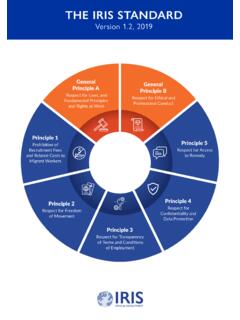Transcription of ISO Standards for Tea
1 1 ISO Standards for TeaIntergovernmental Group-on Tea10thSessionNew Dehli, 12-14 May 2010 Andrew Scott, Chairman ISO TC/34 SC 8 Tea23 Over3milliontonnesproducedInover30countr iesProvidingover1000billioncupsofteaTea4 international Standards are vital to facilitate international tradeTo ensure consumer expectations are metTo provide guidance and common understanding of Good Manufacturing practices via compositional specificationsTo provide validated methods of analysisInternational Standards for Tea51970 s-TeaCommitteebecameISOW orkingGroup8-ISOT echnicalCommittee34 Sub-committee8 Tea1977-ISO3720 Blackteastandard8testingmethodstomeasure basicteaparameters1980-ISO1839 Samplingtea1980-ISO3103
2 Preparationofliquorforsensoryanalysis198 2 -Glossary of terms1990 -Instant tea standard4 supporting test methodsInternational Standards for why measure polyphenols in tea?7 ISO BLACK TEA SPECIFICATION -ISO 3720 1977 (First edition) INTRODUCTION The content of CAFFEINEand the content of POLYPHENOLIC constituents are important chemical characteristics of black tea, but it has not been possible to include limits for either of them in the specification. In the case of CAFFEINE,agreement has not yet been reached on a standard method for the determination. In the case of POLYPHENOLIC CONSTITUENTS, knowledge about test methods is not sufficiently developed to justify the standardization of any oneof the methods in existence; moreover, information on the content of theseconstituents is only available for a few types of tea.
3 81995-Measurement of caffeine in tea and instant tea-Measurement of caffeine in tea, instant tea and decaffeinated tea2005 -Measurement of total polyphenols in tea 2005 -Measurement of catechins in green (and black) teaTea & international Standards9 Substances Characteristic of Tea(15th Meeting ISO/TC 34/SC 8, 1992)ObjectivesFurther development of methods for catechins and total polyphenols in green teasObtain catechin and total polyphenols data on a range of green teas representative of those in international tradeExamine the applicability of these methods for black and oolong teas to facilitate discrimination from greenAlsoCatechin data is needed for the study of the health benefits of tea10 Themethodsshouldbe.
4 -Capabletobeusedbyallscientistsinproduce r&consumercountries-Producereproducibler esultswithinalaboratory-Producereproduci bleresultsbetweenlaboratories-Avalidated methodofanalysisMeasuring Polyphenols11 FolinDenisreagentestablishedasphenolreag enttoquantifytyrosineinproteins, :-phenolsapproximately50%ionisedatpH9-10 -precipitatewithincreasingreagentorsodiu mcarbonateconcentrationorboth-BeerLamber tLawnotstrictlyfollowed-saturatedsodiumc arbonate:variationwithtemperature,equili brationnotrapid-Timingofaddingreagentsim portant-Temperatureandotherfactorsaffect thebluecolourformation-distillingathigha ltitude(Kenyateaestate)notequivalenttoLo ndon/Colworth-empiricalmethodFirsttriale valuatedtheFolinDenisreagent: variabilityduetomakingupthereagentMeasur ing Total Polyphenols12 FolinCiocalteureagentsimilartoFolinDenis reagentandisavailablecommerciallyAdvanta gesFCoverFD.
5 -no precipitation except in excess potassium-more intense and more stable blue colour-no difficulties in preparation off the less colour in proportions to that of FD for possible interfering reductants[high content of active oxidant in FC promoting more complete oxidation and measurement of more slowly reacting phenolics?]Measuring Total Polyphenols13 AgreedtobasetestonamethodpublishedbySing leton&Rossi(1965)usingtheFolin-Ciocalteu reagentTestwasdevelopedbyaworkinggroupof 4laboratoriesTrials:#12black(Kenya&Argen tina)and1green(China)teas#22black(Kenya& Argentina)and1green(China)teasMeasuring Total Polyphenols14 Measuring Total PolyphenolsFirst international ring trial -20 participating laboratories:-showed promising results-identified that training was required for good precision-improvements to protocol required-add a training set of samplesIssues: -sodium carbonate solution.
6 -saturated (Folin Denis) to 20% (Singleton & Rossi 1965)-high blanks-mixing of reagents-timings of additions-colour development time (FC vs FD)-age & batch of reagent differences?-laboratory temperature-extraction -volume variation / extraction recovery for catechins & flavonoids?15 Measuring Total PolyphenolsExtraction: Total Polyphenol & Catechin Analysis-tea must be finely ground (< )-small but representative sample of ground tea ( )-exhaustive double extraction with hot (70 C) 70% methanol give high yield and low catechin degradation -extract samples are stable at 4 C for 24 after preparationNote:-disposable plastic tubes are easier and more reliable to use than re-useable glassware to eliminate trace contamination.
7 -withinlaboratoryrepeatabilitywithoutexc eptionimproved-betweenlaboratoryreproduc ibilityvaluessimilarto1sttrialMeasuring Total Polyphenols17 Measuring Total Polyphenolsy = 0,0132x+ 0,011318 Black leaf tea - Kenya 0 5 10 15 20 25 30 1 2 3 4 5 6 7 8 9 10 11 12 13 14 15 16 17 18 19 20 21 22 23 24 Laboratory Number Total Polyphenols % on DM Mean Green leaf tea - China 0 5 10 15 20 25 30 1 2 3 4 5 6 7 8 9 10 11 12 13 14 15 16 17 18 19 20 21 22 23 24 Laboratory Number Total Polyphenols % on DM Mean Black leaf tea - Argentina 0 5 10 15 20 25 30 1 2 3 4 5 6 7 8 9 10 11 12 13 14 15 16 17 18 19 20 21 22 23 24 Laboratory Number Total Polyphenols % on DM Mean 19 Measuring Total Polyphenols20 Totalextractionofpolyphenols:ISOB lacktea (54samples)Greentea (102samples).
8 557mg/lpolyphenolsinabrewedcupoftea(71sa mples)Measuring Total Polyphenols2122 Themethodshouldbe:-Capabletobeusedbyalls cientistsinproducer&consumercountries-Fi tforthepurpose-Producereproducibleresult swithinalaboratory-Producereproduciblere sultsbetweenlaboratoriesMeasuring Catechins23 UsesHPLC toseparatetheconstituentsandmeasurestheU Vabsorbanceoftheindividuallyseparatedcat echinsSamples Stage1instantteas 1green&1black-Stage2:2greenteas[Chinasml f&Chinaboldlf]2blackteas[DarjeelingSnowv iew&Lingia]Removeallvariationotherthanla boratorytesting:-thesamecolumnsused(Unil everprep)[PhenomenexLuna 5 4x3mmPhenyl-Hexylguard]-purecatechinstan dardsused(Unilever)-teasamplesgroundtopo wderandmixedtohomogeneityMeasuring Catechins24 Extraction-sameasTotalPolyphenolAnalysis HPLC conditions-HPLC withLuna Phenyl-Hexylcolumnimprovesresolutionofca techinscomparedwithC18-UVwavelengthdetec tion(278nm)-Temperaturecontrolto35 Ctomaintainresolutionandpreventdriftingp eaks-Solventgradient2%aceticacid-acetoni trilewithEDTA.
9 Acetonitrile9-32%over15mins-Samplesforan alysisaredilutedinstabilisingsolutioncon tainingEDTA andascorbateinacetonitrile-Oxidation(met alcatalysedorotherwise)mustbeavoidedforr eproducibleresultsindilutesolutionsMeasu ring Catechins25 Testwasdevelopedbyaworkinggroupof4labora tories#1 Internationalringtrial-17laboratoriespar ticipated:16resultswerereturnedIssues:-a dequate within laboratory -variability between laboratories-recalculation of data using consensus relative response factors improved repeatability-RRF s viable approach for quantitation of catechins [pure catechins not readily available, impure and very costly]-variability most likely due to degradation during chromatography (metal contamination) -> include EDTA in mobile phaseMeasuring Catechins26#2 international ring trial-17 laboratories participated:14resultswerereturnedStatis ticalmethods.
10 Cochranetest(duplicates),Dixontest(betwe enlaboratories),Friedmantest(consistenth ighs/lows)Relativeresponsefactorrelative tocaffeinestd(moreconvenientretentiontim ethangallicacid)Standardpurityassessment s[HPLC,NMR,moisture]Measuring Catechins27 Comparisonofstatisticalanalysisresultson recalculatedRRF svsLaboratory scalibrations:-totalcatechinvalueslowera saconsequenceofusingstandardRRF Catechins28293031 Green Leaf Tea - Sample 105101520251234567891011121314151617 Laboratory on DMMean Leaf Tea - Sample 205101520251234567891011121314151617 Laboratory on DMMean Leaf Tea - Sample 305101520251234567891011121314151617 Laboratory on DMMean Leaf Tea - Sample 405101520251234567891011121314151617 Laboratory on DM Mean Catechins33 Measuring Catechins34 Measuring Catechins35 Totalcatechincontent.













